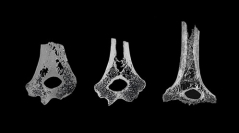

 Comptes Rendus Palevol
16 (5-6) - Pages 521-532
Comptes Rendus Palevol
16 (5-6) - Pages 521-532The taxonomic attribution of isolated hominin distal humeri has been a matter of uncertainty and disagreement notwithstanding their relative abundance in the fossil record. Four taxonomically-based morphotypes, respectively representing P. boisei, P. robustus, non- erectus early Homo and H. erectus, have been identified based on the cross-sectional outer shape variation of an assemblage of Plio-Pleistocene eastern and southern African specimens (Lague, 2015). However, the existence of possible differences between Paranthropus and Homo in the inner structural organisation at this skeletal site remains unexplored. We used noninvasive imaging techniques to tentatively characterize the endostructural organization of five early Pleistocene distal humeri from South Africa (TM 1517g, SK 24600, SKX 10924, SKX 34805) and Ethiopia (Gombore IB), which have been variably attributed to Paranthropus or Homo. While the investigated specimens reveal diverse degrees of inner preservation related to their taphonomic and diagenetic history, in all but SK 24600 from Swartkrans we could comparatively assess some geometric properties at the most distal cross-sectional level (%CA, Ix/Iy, Imax/Imin ) and quantify cortical bone thickness topographic variation across the preserved shaft portions by means of a 2-3D Relative Cortical Thickness index. Whenever possible, we also provided details about the site-specific organization of the cancellous network and measured the same parameters in a comparative sample of twelve adult extant humans. For most features, our results indicate two main patterns: the first includes the specimens TM 1517g, SKX 10924 and SKX 34805, while the second endostructural morphotype sets apart the robust Homo aff. erectus Gombore IB specimen from Melka Kunture, which more closely resembles the condition displayed by our comparative human sample. Notably, marked differences in the amount and pattern of proximodistal cortical bone distribution have been detected between Gombore IB and SKX 34805 from Swartkrans. Given its discordant outer and inner signatures, we conclude that the taxonomic status of SKX 34805 deserves further investigations.
Distal humerus, Inner structure, Cortical bone topography, Paranthropus, Homo